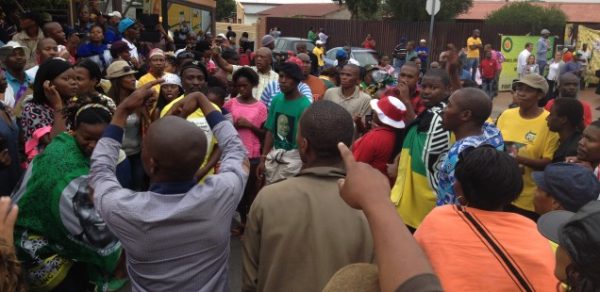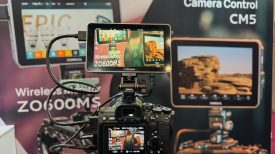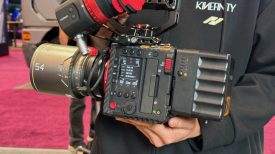Guest post by Christian Parkinson of imagejunkies.com:

I arrived in Johannesburg excited for my upcoming documentary shoot in Lesotho. Leaving the plane I sleepily switched my phone back on and it immediately began to beep with incoming text messages. Nelson Mandela had died.
The death of Mandela is a story I’ve been preparing for for many years – when I was the BBC Africa bureau cameraman the fear of his death had always hung heavily over us, we all knew it could happen at any time and that the story would be huge. Now it had happened I felt sad for his family and for South Africa but relieved that he had finally found peace.
Our documentary shoot was now going to be postponed so that we could help our BBC News colleagues to cover this massive story.
I spoke to my bosses in London and took a taxi to Soweto to begin putting together my own films as a solo video journalist. I’ve been a cameraman and editor my whole career, but in the past few months have tried my hand at solo work and found it an interesting new challenge.
I know Soweto well (my wife is from there) and decided that instead of heading for Mandela’s old house on Vilakazi street I would go and get reaction from normal Sowetans. I found a busy garage near Bara hospital and made this film with two of the staff about how they had found out Mandela had died and how they felt. It was shot on my Sony PMW 500 and edited in a hurry on Final Cut Pro 7.
After the rush and scramble of the first day, other BBC crews and reporters began to arrive, allowing me to focus on finding interesting and quirky stories and trying to tell them in different ways. The Sunday after his death was a national day of prayer, but I decided to skip a visit to the big churches and the hordes of camera crews that I knew would be there. Instead I sought out a small church on the edge of Soweto for this film with local Pastor Joel Serasengwe. Most of it was filmed on my PMW 500 but a few shots were done on my Canon S110 compact with a Manfrotto monopod (you may notice the overhead shot that was done with this rig.)

The next big event for me to cover was the memorial service at the FNB stadium. It was expected to be massive with dozens of heads of state including President Obama. My style of filmmaking is very relaxed and informal and I realised that the “added value” that I could offer for this day was to spend it in the crowd soaking up the atmosphere with a small camera so that I didn’t intimidate anybody around me. Unfortunately the day was wet and the atmosphere was flat. I made the film below using my Canon S110 with no accessories and using the built-in mic. As always with a camera like this, exposure, sound and focus always cause problems. I filmed interviews so close to the interviewee that the sound would pick up. I also had to be careful what backdrop I used because the camera’s auto exposure isn’t great and will hunt a lot before it is happy. There is a way to compensate for exposure on the S110 but I find it fiddly and slow. Below is the film that I put together that evening. I hope it captured something intimate in a way I couldn’t have done with a big camera as part of a three person crew.
As the rest of the week progressed I continued to avoid the big stories and focus on everyday people and what Mandela meant to them. I was particularly happy with this fun piece looking at three ways that they were remembering the man they call Tata Madiba. Most of this was shot on my Sony PMW 500 except for the short sequence of flowers being laid and the shot taken from behind the steering wheel, both of which were shot on my Canon S110.
I then put together this piece that shows how much the spirit of Mandela and forgiveness has been taken on board by many in South Africa. Tshepo Ncholo was killed during a botched carjacking in 2003. During the subsequent trial it emerged that his murderer was a high school drop-out whose parents were dying of HIV. Tshepo’s older brothers took pity on the man and, inspired by their religious beliefs and the example of Mandela, they decided to help their brother’s killer and his family.
It was decided that I wouldn’t head to Qunu for Mandela’s burial. The event was being covered by so many other teams that I felt I could achieve more elsewhere. Instead I made the film below that ran on BBC World news on the Saturday (the day before his funeral). I thought that it was important to hear a different voice, and to hear why some South Africans worry that the media and politicians are so focused on the great work that Mandela did that they are in danger of forgetting the countless thousands who also made huge sacrifices for South Africa’s liberation.
As Mandela was buried, I began to pack ready for the long flight home. I was generally pleased with the films that I’d made, but, as always, I felt I had compromised too much on my shooting. I find that when I work alone I often rush and I’m so busy making the interviewee feel relaxed, and hearing their story, that I sometimes miss an obvious shot or sequence. I really do appreciate working with a quality reporter who can keep the small talk going while I set up and look for shots. I guess that is the compromise that a one-man-band always has to make. But all in all I was glad to have been there and to have been able to tell so many stories of everyday South Africans and how Nelson Mandela had inspired them and touched their lives.
Christian Parkinson is a cameraman and video journalist based in London and covering the world. His work has won the David Bloom award and was shortlisted for an International Emmy. Christian is currently writing a book about how to succeed as a news cameraman. He also edits the popular camera blog www.imagejunkies.com and on twitter is @imagejunkies






